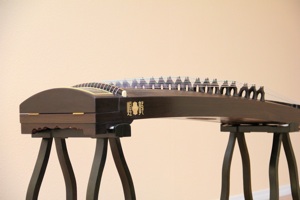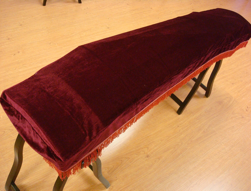Online Tutorials on
1. How to set up a Guzheng.
2. How to tune a Guzheng.
3. How to take care of a Guzheng.
4. How to play a Guzheng.
1. How to set up a guzheng:
Set up the stands by placing the taller/wider one of the two-piece stands on your right and placing the shorter one on your left. Keep them 3 feet apart from each other.
(2) Carefully remove the instrument from its packaging material and place the gu zheng on the stands. The head of the instrument (the wider end) needs to be placed on top of the right-side stand and lock into the curved part. The tail should be on the left-side stand about 1 foot away from the extreme end of the instrument.
(3) Unpack the bridges. Line them up on a table in the order of 1 to 21. You can find the number labels on the inside of the bridges. Place bridge #21 underneath the thickest string. The distance between this bridge and the end of the string (tail side) should be around 82 centimeters. After that, determine the initial positions of the rest of bridges according to the bridge order and effective string length (please see user’s manual for charts and details.)
(4) Using the tuning wrench to tighten each of the strings by rotating the tuning pin forwardly. Pull the string upward to let it stretch. Then tighten the string again. Repeat the above actions until the strings are settled.

taller stand on the right
in-between 130cm
shorter stand on the left
bridge #1 15cm

bridge #21

82cm
2. How to tune a guzheng:
(1) Modulate string #8 (in green color) to the standard pitch ( tuning fork A440Hz) , string #1 (the highest tones) to d3 ( 1174.7Hz), string #21 (the lowest tone) to D (73.4Hz) with the rest strings modulated on the basis of 5 musical scales
(1/D-2/E-3/F#-5/G-6/B). You may use a digital tuner as your reference.
(2) As strings 1-10 are very thin, the corresponding bridges shall be discharged before these strings are tightened for modulation, so as to avoid breaking the string.
After the newly unpacked instrument has been initially modulated, the tension of the strings still requires further adjustment. For doing so, press the strings with fingers repeatedly till the tension is relatively stable.
The strings are consumables ( especially strings 1-10,) additional strings shall be prepared for replacement. In case any strings gives husky or muffled sound or damaged on any aspect, such string shall be replaced immediately.
(3) Move individual bridges by holding the bottom of the bridge with your left thumb and middle finger. Using your right hand to pull up the string to release its tension from the bridge. Then move the bridge to the right (higher note) or to the left (lower note.) After moving the bridge, make sure it stands stably on the soundboard.
(4) New Guzhengs get out of tune very frequently. You will need to tune your instrument accordingly. Always play on an in-tuned instrument. That is basic :).
Try not to rely on a digital tuner. Really listen and remember the pitches. Practice tuning with your ears. If you just focus, you will hear the difference!
Please see the user’s manual for tuning chart and instructions. All smartphone users, download a free app called “Pano Tuner” onto your phone which is more sensitive and accurate than a conventional digital tuner, and it is FREE!

3. How to take care of a guzheng:
Your instrument should be handled with care to avoid collision or sharp vibration. It should be kept in a dry , cool and well-ventilated room and away from direct sunlight, moisture and rains. In northern areas where it is cold in winter, the instrument shall be kept away from heat radiators to avoid damage or deformation. Never place the instrument in a kitchen or any place where it may be easily in contact with oil fumes, which may have impact on the tone quality. Wipe the instrument clean with dry soft cloth after playing, to prevent the stings from rusting. The instrument should be covered to avoid the intrusion of dusts, light and moisture if it is not in Use.
The instrument should be played frequently so as to maintain a stable tension on the strings and the make the instrument resonate frequently to achieve an increasingly perfect tone quality. The accuracy of the tones from the instrument may succumb to the influence of temperature, humidity and vibration. Once tones are inaccurate, modulation should be conducted immediately, otherwise the performance maybe affected. Servicing shall be conducted regularly. Clean the instrument body with a soft brush or dry soft cloth. Never rinse the instrument with water. Use travel bag for non-air travel. Take out the bridges and put the Guzheng into a hard case when travel on airplanes.
4. How to play the guzheng.
Self-Learning Method Book
Video Tutorial (coming soon, please check back!)
Facebook page
Take Skype Lesson From Professionals

